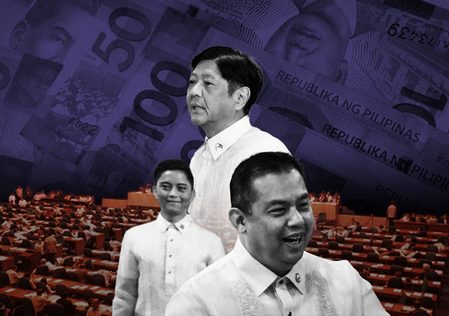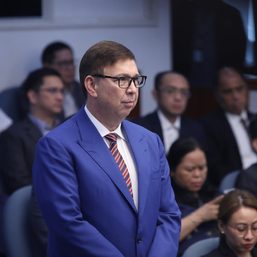SUMMARY
This is AI generated summarization, which may have errors. For context, always refer to the full article.

MANILA, Philippines – Now that the implementing rules and regulations (IRR) for the Maharlika Investment Fund (MIF) Act has been released, we have a more concrete idea about what the controversial measure will look like.
The IRR was first made available on the Official Gazette’s website on Wednesday, August 30, a day after Finance Secretary Benjamin Diokno confirmed its publication. It will take effect on September 12, less than a year since the measure was first introduced in Congress. (READ: Implementing rules for Maharlika fund are out)
A pet project of President Ferdinand Marcos Jr., the bill was certified as urgent, allowing it to race through both houses of Congress. The fund has the ambitious goal of being a “crucial financing mechanism to widen fiscal space, ease the burden on local funds, and reduce reliance on official development assistance in funding big-ticket infrastructure projects,” according to Diokno, who eyed investments in public road networks, tollways, railways, green energy, water resources, agro-industrial ventures, and telecommunications.
Where will funding come from?
Upon its creation, the Maharlika Investment Corporation (MIC) will have an authorized capital stock of P500 billion. The initial P50 billion will come from various government sources, including a 100% dividend contribution of the Bangko Sentral ng Pilipinas (BSP) for two years, a 10% contribution of revenues from government-owned gaming operators, privatization of government assets, among others. This will be deposited in an account designated for the MIC “in accordance with the instruction of the Secretary of Finance.”
Land Bank of the Philippines (Landbank) and the Development Bank of the Philippines (DBP) will contribute P50 billion and P25 billion respectively in starting capital to the fund. Both state banks are required to deposit the amounts with the Treasurer of the Philippines within 5 days of the IRR’s effectivity, or on September 17.
GFIs and government-owned and -controlled corporations may invest in the fund as well, but those providing social security and public health insurance are “absolutely prohibited” from putting money in the wealth fund. Among those banned from investing are the Social Security System, Government Service Insurance System, Philippine Health Insurance Corporation, Pag-IBIG Fund, Overseas Workers Welfare Administration, and Philippine Veterans Affairs Office Pension Fund.
The IRR also specifies that investments can come from “reputable private and state-owned financial institutions and corporations in the form and under the terms and conditions that the Board of Directors may prescribe.”
The MIC can also issue bonds, debentures, and securities to gain more funding, but none of this will be guaranteed by the government.
Who will head the Maharlika fund?
The MIC’s board of directors will be headed by the finance secretary serving as the ex-officio chairperson. The president and chief executive officer of the MIC will sit as the vice chairperson. Other members include the president and CEO of both Landbank and DBP, two regular directors, and three independent directors from the private sector.
The finance secretary and representatives from Landbank and DBP may designate an alternative to sit in their place, provided that they are at least an undersecretary or executive vice president in rank.
The president and CEO of the MIC will supervise the operations and internal administration of the company, and will lead the risk management, financial performance, human resources, accounting, and legal affairs of the MIC.
The two regular directors will be appointed by the President upon recommendation of the MIC’s advisory body. They will serve a term of three years, unless removed earlier.
Meanwhile, the independent directors will be appointed by the President for a term of one year, with a possibility of reappointment, provided that their cumulative term doesn’t exceed nine years.
What are the requirements for board members?
The president and CEO of the MIC must hold a master’s degree in finance, economics, business administration from a reputable university, and have a minimum of 10 years of experience in finance or investment, along with 10 years in a senior leadership role at a reputable financial institution.
Regular directors are required to be Filipino citizens of at least 35 years of age with a good moral standing and reputation with substantial experience in corporate governance and administration, investment in financial assets, and management of investments in the global and local markets. The IRR doesn’t specify any requirements for the citizenship or the age of independent directors.
All directors must also have a master’s degree and a minimum of 10 years of experience in finance, investments, economics, business, or related fields. They should also have “demonstrated commitment to the highest ethical standards, integrity, and compliance with relevant laws and regulations.”
What are some of the safeguards?
Diokno, along with other supporters of the measure, emphasize that the MIF will have three layers of audit: an internal auditor, an external auditor, and the Commission on Audit (COA). (READ: Ex-BSP chief Medalla: Let’s see how Maharlika can be less a danger to PH economy)
The internal auditor must be independent from the management of the MIC, while the external auditor must come from an “internationally recognized auditing firm” that can only conduct annual audits for a maximum engagement period of three consecutive years.
COA will also go over the books and accounts of the MIC based on the state auditor’s guidelines, with a special audit conducted every five years.
Auditors are also required to assess the MIC’s implementation of the Santiago Principles, a set of internationally accepted best practices for sovereign wealth funds. However, the IRR doesn’t specify explicit penalties for non-compliance with the principles.
The Maharlika Investment Fund Joint Congressional Oversight Committee – composed of seven members each from the House of Representatives and the Senate – will review quarterly confidential submissions of the MIC’s planned investments and the audit reports.
The joint committee will be co-chaired by the chairpersons of the House Committee of Banks and Financial Intermediaries and the Senate Committee on Banks, Financial Institutions, and Currencies. The House Speaker and Senate President will designate the other members.
The board will also have a risk management committee composed of one independent director as chairperson, one ex-officio member of the board, one regular director, and two senior executives of the MIC. There will also be an audit committee made up of one independent director as chairperson, one ex-officio member of the board, one regular director, and two senior executives of the MIC.
The advisory body – which has the power to provide guidance on the MIC’s projects and recommend candidates for the director position – will consist of the secretary of the Department of Budget and Management, secretary of the National Economic and Development Authority, and the treasurer of the Philippines.
However, not all economists agree that the MIF has sufficient safeguards. By creating the MIF, economists worry that funding for some projects could bypass the normal budget process, which could decrease Congress’ power to scrutinize them. Redirecting tens of billions from the Landbank, DBP, and the BSP could also require the government to take on more debt from other sources.
– Rappler.com
Add a comment
How does this make you feel?



![[In This Economy] Is the Marcos government unlawfully dipping into PhilHealth funds?](https://www.rappler.com/tachyon/2024/07/marcos-government-philhealth-funds-july-12-2024.jpg?resize=257%2C257&crop=425px%2C0px%2C1080px%2C1080px)


There are no comments yet. Add your comment to start the conversation.